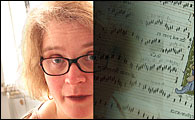Music to the ears
Anyone who's walked by the Strathcona Music Building since last summer would be hard-pressed to miss the massive billboards announcing the construction of the Faculty of Music's long-awaited new building.
 Cynthia Leive
Cynthia LeivePHOTO: Claudio Calligaris |
|
What's unknown to most people, so far, is the list of marvels that will be housed in the upcoming structure.
Cynthia Leive knows. As head of the Marvin Duchow Music Library, Leive is part of the planning committee for the new facilities. She's thrilled to reveal that her domain will occupy three floors of the future building on Sherbrooke and Alymer Streets.
"We expect to move in by the summer of 2004," she says. "We're really looking forward to reuniting with the rest of the Faculty of Music."
Leive, who's been working at the Music Library for 16 years, fondly recalls when the library was still ensconced in Strathcona. "In the old days, people used to be able to routinely run in and out to gather information," she says.
That was before space crunches, and poor physical conditions, forced the library to be moved south to an office tower at 550 Sherbrooke St. W. "Being across the street means people have to plan their visits," Leive explains. "You need boots and layers of clothing just to get here."
While the library was always meant to return to the north side of Sherbrooke, lack of funding for a new building has prolonged reintegration. "What was supposed to be a temporary fix turned out to be an 11-year-old solution," Leive says.
Ten years of fastidious fundraising and planning efforts have finally enabled McGill to collect the majority of funds for the library and music building. The Weston pool will be razed this winter to make room for the new structure.
McGill will soon announce the size, cost and the many unique features of the facilities. The project design is complete and goes to tender at the end of this month. Pre-tender work is already underway and by March construction will be in full swing.
The current library occupies 14,000 sq. ft. Once moved, the modern facilities will be spread over 30,000 sq. ft. Boosting space is a pressing need. Library usership is on the rise and collections are expanding. Leive, the one librarian, her four assistants and several student casuals welcomed about 200,000 visitors last year. "Libraries need room to grow and we've run out of space," Leive warns.
The library holds 25,000 books, 250 periodical subscriptions, 45,000 volumes of musical scores and a 5,000-title microfilm collection. An ever-changing array of audiovisual recordings is stockpiling: 30,000 LPs, 18,000 CDs, and several hundred videos and DVDs. But lack of space means thousands of LPs are stacked in cardboard boxes - there simply isn't enough space to properly house them.
"We have 100 years worth of sound recordings that students need to consult to enhance their own performances or to compare historical production values and recording techniques to today's technology," Leive says, adding the new library will include 78 listening stations.
Changing venues will also permit a merger with the Performance Library. The latter, which is still in Strathcona, caters to ensembles and contains scores and parts. Combining both libraries, Leive stresses, will improve service for users and enhance working conditions for staff. The new digs will also feature a state-of-the-art video viewing room, three large seminar rooms, and study areas.
The library will even provide virtually integrated technology with the rest of the building that will enable new teaching possibilities. For instance, if musicians are playing in a recording studio on another floor, the event could be beamed to library conference rooms for student viewing.
Rare and special collections will also be protected in a room with proper climate controls. "Our new facilities will be high-tech and yet very user-friendly," Leive says. "We're going to loosen things up a lot. We'll have better views and more comfortable seating."
Leive considers the library the nucleus of the Faculty, which makes building new facilities critical. "This is more than a place to pick up books, scores or audio-visuals," she says. "Music libraries are to musicians what labs are to scientists."

